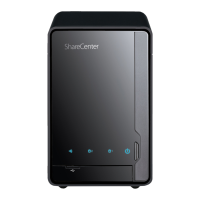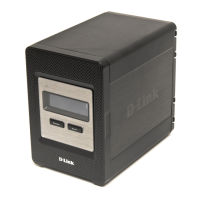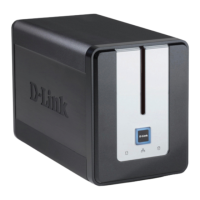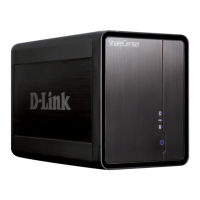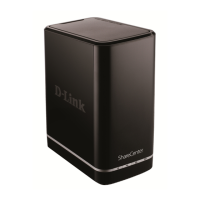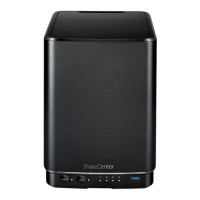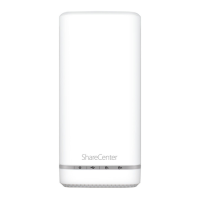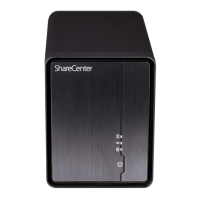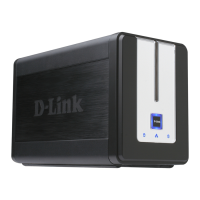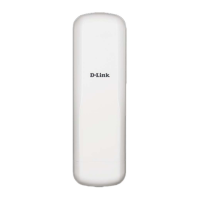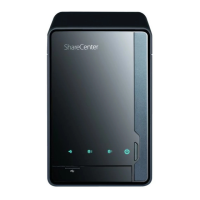
Do you have a question about the D-Link ShareCenter Pulse DNS-320 and is the answer not in the manual?
| power supply | External Power Supply |
|---|---|
| power consumption (normal mode) | 15.7 W |
| power consumption (sleep mode) | 8.2 W |
| operating temperature | 0˚ to 40˚ C (32˚ to 104˚ F) |
|---|---|
| storage temperature | -20˚ to 70˚ C (-4˚ to 158˚ F) |
| operating humidity | 5% to 90% (Non-condensing) |
| ethernet port | 10/100/1000 Gigabit Ethernet Port |
|---|---|
| usb port | 1 USB 2.0 Port |
| supported hard drive type | 3.5” Internal SATA (Maximum HDD Capacity: 2 TB for each drive) |
| dimensions | 146.4 x 115 x 178.5 mm (5.8 x 4.5 x 7.0 inches) |
|---|---|
| weight | 0.85 kg (1.87 lbs) |
Introduces the D-Link ShareCenter Pulse DNS-320 and its capabilities.
Lists all the items included in the product package.
Specifies the minimum system requirements for using the device.
Highlights the key features and functionalities of the DNS-320.
Details the components of the device's front panel.
Explains the ports and components on the rear of the device.
Guides users on using the included CD to launch the setup wizard.
Explains how the setup wizard guides users through device configuration.
Details the process of opening the device and sliding in the hard drives.
Instructs on attaching the top cover after drive installation.
Explains how to connect the ShareCenter Pulse to the network using an Ethernet cable.
Guides on connecting power, turning on the device, and confirming its detection.
Explains how to set or change the administrator password for the device.
Details configuring IP settings (DHCP/Static) and network workgroup for the device.
Explains how to configure Dynamic DNS for remote access via a URL.
Covers creating a DDNS account and setting the device's time and time zone.
Guides on configuring email alerts and viewing volume information.
Explains selecting RAID types and mapping volumes as network drives.
Details reviewing configuration summary and the drive formatting process.
Shows the confirmation screen upon successful hard drive formatting.
Displays the final confirmation of successful device installation and network mapping.
Details the process of logging into the device's web-based management interface.
Describes the layout of the Web UI, including tabs and configuration icons.
Outlines the contents of the Management tab, including various configuration submenus.
Explains how to access and start the device's Web UI Setup Wizard.
Guides on setting the administrator password during the setup process.
Explains how to select the correct time zone for the device.
Details configuring network connection type (DHCP or Static IP).
Covers setting the workgroup, name, and description for the device.
Guides on entering email parameters for sending event alerts.
Explains accessing disk management for RAID configuration and drive formatting.
Describes the wizard for formatting drives and creating RAID configurations.
Guides on selecting the desired RAID type (Standard, JBOD, RAID 0, RAID 1).
Explains how to enable or disable the Auto-Rebuild feature for RAID 1.
Details setting the volume size for RAID 0 or RAID 1 configurations.
Displays a summary of the volume configuration before proceeding with formatting.
Shows the progress bar during the hard drive formatting process.
Displays the final configuration table after formatting is complete.
Explains how to perform S.M.A.R.T tests to monitor hard drive health.
Details creating schedules for S.M.A.R.T. tests.
Describes how to scan the disk file system for errors and corruption.
Introduces account management for creating and managing user and group accounts.
Guides on creating new user accounts, joining groups, and configuring settings.
Explains adding a user to a specific group.
Guides on configuring network access rights (Read Only, Read/Write) for users.
Details assigning application privileges like CIFS, AFP, FTP, WebDAV.
Explains configuring WebDAV access rights for user accounts.
Guides on setting storage quotas (in MB) for user accounts.
Guides on creating new group accounts and configuring their settings.
Explains selecting users to add to a new group.
Guides on assigning network access rights for groups.
Details assigning application privileges (FTP, WebDAV) for groups.
Guides on setting storage quotas for group accounts.
Guides on reviewing and finalizing the group creation process.
Details how to enforce storage quotas for users and groups.
Explains configuring shared folders and access rights for users and groups.
Guides on creating new network shares by selecting folders and setting access rights.
Explains selecting users or groups for shared folder access.
Guides on assigning specific access rights (Read Only, Read Write, Deny Access).
Details setting access rights for individual users on a share.
Details setting access rights for groups on a share.
Explains assigning privileges like oplocks for network shares.
Guides on assigning protocol privileges (FTP, NFS, WebDAV) for shares.
Details configuring FTP access settings for network shares.
Explains configuring NFS access settings for network shares.
Guides on configuring WebDAV access settings for network shares.
Guides on reviewing and saving the network share configuration.
Guides on creating new ISO mount shares for virtual drives.
Explains setting access rights for users/groups to ISO mount shares.
Guides on assigning read-only or deny access privileges for ISO mount shares.
Allows adding comments to describe the ISO mount share.
Guides on assigning protocol privileges for ISO mount shares.
Guides on reviewing and saving the ISO mount share configuration.
Explains how to change the administrator password.
Introduces network management settings for the device.
Guides on configuring Ethernet link speed and LLTD settings.
Provides detailed settings for configuring Dynamic DNS services.
Details how to configure and manage the built-in FTP server.
Guides on enabling and managing the UPnP AV Server for streaming media.
Explains how to set up and use the iTunes Server for sharing music and videos.
Guides on enabling the Apple Filing Protocol (AFP) for MAC OS connectivity.
Explains enabling the Network File System (NFS) service for multi-platform access.
Allows users to customize and organize frequently accessed functions.
Describes how to rearrange icons in the My Favorites tab for easier access.
Details methods for adding icons from Applications or Management tabs to My Favorites.
Explains how to remove icons from the My Favorites tab.
Describes how to install and manage language packages for the system.
Guides on setting the device's internal clock, time zone, and synchronizing with NTP servers.
Explains how to set the workgroup, name, and description for the device.
Covers restarting, restoring defaults, and shutting down the device.
Details saving and loading system configuration settings to/from a file.
Explains configuring idle time limits for users accessing the web UI.
Guides on setting system temperature thresholds for automatic shutdown.
Explains configuring HDD hibernation and power recovery features.
Describes how to control fan speed settings.
Guides on scheduling automatic power off times for the device.
Covers configuring email and SMS alerts for system events and drive status.
Explains how to manage system logs, FTP logs, and configure Syslog functionality.
Guides on checking for and performing firmware upgrades for the device.
Shows network settings, workgroup, name, description, and uptime.
Provides detailed information about installed hard drives, including status and health.
Guides on scheduling file and folder backups from FTP or web servers.
Details settings for download destination, renaming, language, and scheduling.
Explains how to configure remote backup jobs to other ShareCenter Pulse or Linux servers.
Guides through the wizard for creating new remote backup jobs.
Details task name, folder path, and remote IP for backup jobs.
Covers remote IP, encryption, and ignoring existing files for NAS to NAS backups.
Guides on selecting the remote file system path for backup jobs.
Explains manual, once, or scheduled execution of remote backup jobs.
Guides on reviewing and saving the remote backup job configuration.
Explains scheduling local file and folder backups from network shares or local computers.
Guides on configuring the device as a backup destination for Mac OS X Time Machine.
Details configuring P2P download management settings, schedules, and bandwidth.
Explains adding torrents, managing download tasks, and using navigation controls.
Guides on accessing files remotely via a web browser using the Web File Server.
Explains configuring and using AjaXplorer for remote file management via a web browser.
Defines RAID and explains its levels (JBOD, RAID 0, RAID 1) for data storage.
Guides on using the Easy Search Utility to map network drives to a computer.
Details selecting devices, volumes, drive letters, and connecting mapped drives.
Illustrates accessing mapped drives through 'My Computer'.
Explains how to map the device's Recycle Bin as a network drive.
Guides on setting up and using the USB Print Server to share printers on the network.
Details the Windows Add Printer Wizard and driver selection for USB printers.
Shows the installation confirmation and printer queue appearance.
Guides on installing and configuring Yahoo! Widgets for the device.
Explains what information is displayed in the different sections of the Yahoo! Widget.
Details using the USB Copy button to automatically copy USB contents to the device.
